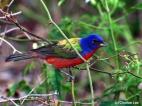



 The painted bunting is easily the most colorful bird we have migrate through south Texas. I borrowed the first pictures. Only the last one here is one I took.
The painted bunting is easily the most colorful bird we have migrate through south Texas. I borrowed the first pictures. Only the last one here is one I took.The Painted Bunting is the most breathtakingly colorful of North American birds. The male has a blue head, green in back with a red rump and underparts. The female is green above and yellowish-green below. And though not as brightly colored as the male is still easily identified.
This southern cousin of the Indigo bunting is found mainly in southern states and Mexico, where the brushy, weedy shrub-scrub habitat that this bird prefers abound.Although colorful, this bird can be hard to spot as it forages for seeds in shrubs and on the ground.
Though in the past this bird was a frequent visitor of our eastern seaboard, its numbers there have declined about 3 % per year since the Breeding Bird Survey (BBS) began in 1966. Declines are mainly due to loss of shrub-scrub habitat that this birds prefers. The nest parasitism of the Brown headed cowbird also contribute to there decline.
Length 5 - 5 1/2 inches
1 comment:
WOW - that is a beautiful bird! I don't believe I've ever seen one in person so colorful! Keep those great pictures coming :o)
-Kristi
Post a Comment